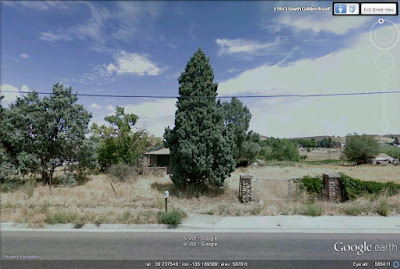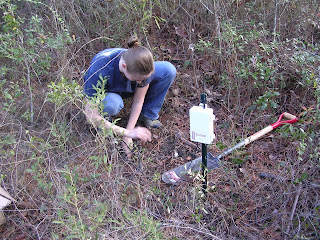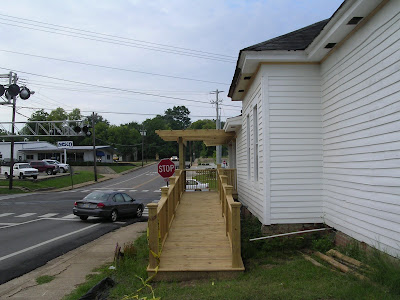I am trying to write an end-of-the semester paper and am going over some ideas from an old class and came across this paper. I thought it was pretty good. Read on if you want to take in your humble blogger's thoughts on science, knowledge and GIS.
The Status of
Geographical Information Systems in Academia
By Toby Gray
GR 8990
Philosophy and Ethics
in Geography
March 23, 2011
The
computational power and graphic capabilities of Geographical Information
Systems (GIS) have brought
dramatic changes to geography and allied fields, just as the wider so-called
“digital revolution” has profoundly changed human civilizations worldwide.
Complex operations in spatial statistics, such as kriging, to take one example,
which in the pre-digital age required advanced technical knowledge and
laborious, time-consuming effort, can now be done by anyone instantly. These
technical advances promulgate new questions of appropriateness, privilege, map
interpretation and epistemological assumptions. The basic questions have been
around for a long time in the disciplines of geography, cartography, landscape
architecture, ecology and allied fields. The complex and dynamic
epistemological environment created by the technological advances of GIS constitute a new field of knowledge appropriate
for advanced study. We have moved well beyond the notion, discussed by Wright
et al. (1997) and Goodchild (1992), that GIS
is a mere software package appropriate only in an undergraduate curriculum for
students who want to apply it to the science of geography.
As a new
technology in the process of expansion and homesteading in new intellectual
fields and territories, the ontological status of GIS
within the academy is still undetermined. As external entities, particularly
governmental agencies, demand more GIS-based
products, the funding status of GIS
seems sound. But where does GIS
fit in an academic institution? As an area of technical expertise? As a unit
within geography? Or as an emerging autonomous science breaking away from her
more established cousins, much like geography in the 1880s?
These
questions have been addressed in a number of papers in terms of a “tool or
science” debate. This debate actually informs and advances a larger debate
about the ontological status of science more than it demystifies the
ontological status of GIS. This
paper will argue that the answer to the “tool or science” question depends on
how one defines those terms, a very tricky problem in and of itself. I will
argue that many geographers, leery of being associated with expressions of
positivism, define science so broadly that, in the end, nothing is science. I
will advocate for a strict, positivist definition of science, one that
relegates GIS to the tool
category. I will also assert that mathematics and languages are also tools and
that tools have primacy over science and are therefore certainly worthy of
post-graduate study.
In order to
determine whether GIS is a tool or
a science one must first define the terms “tool” and “science.” Pickles (1997)
takes Wright et al. (1997) to task for failing to adequately define “science,”
ignoring that fact that they don’t even attempt to define “tool.” The problem,
of course, is that any attempt to define “science” involves the writer in thorny,
centuries-old philosophical debates. These debates have taken on a sharper
focus in the last few decades due to the post-modernist, or deconstructivist,
critique of the more excessive claims of positivism, and to efforts by “human
geographers” to expand the field of science to include more dynamic and
meaningful kinds of epistemologies. When Wright et al. (1997) do define
“science,” they do so in the context of disassociating science with positivist
expression, resulting in a definition that could conceivably include the arts
and sciences. Goodchild (2000), by contrast, in an unambiguously positivistic
stroke, includes an image of Pieter Brueghel’s “The Tower of Babel” (1563) with
his essay and ends on an unapologetically positivistic note regarding the
capabilities of digital spatial technology for the creation of “a new Tower of Babel, to be created by a conscious
effort to overcome problems of communication.”
A Broad Definition of Science Makes Everything a Tool
Goodchild
(2000) is virtually alone in his willingness to express faith in the power of
quantifiable fields of data and logical processes, the structure of GIS, to solve problems and advance civilization in
any meaningful way. Wright et al. (1997) mention that GIS
is perceived by some as “positivisms second coming” and by others as “a
last-ditch rally by positivism’s battered survivors.” It is amusing to wonder
where Goodchild is in this scenario. We should also note that Goodchild is a
co-auther of the Wright et al. (1997) paper.
Wright et
al. (1997) are more cautious when it comes to associations with positivist
expression. They doubt that a concise definition of science is even possible.
Science, they say “encompasses a wide range of fields that differ widely from
each other in philosophy, knowledge content, and methodology.” They offer one
definition of the term “science” as “shorthand for a logical and systematic
approach to problems that seeks generalizable answers.” In their conclusion
they note “older notions of science as the equivalent of “hard science” are
being replaced by a more open view.” They mention Johnston’s (1986) view of science as “the
pursuit of systematic and formulated knowledge, and as such [it] is not
confined to any particular epistemology.”
The problem
with such definitions is that they don’t exclude the arts and humanities, which
are also “systematic and formulated.” Scholars in literary criticism, history
or comparative literature do not employ symbol-based formulas to the degree that
scientists do, but their individual works of scholarship do not exist in a
vacuum either. On the contrary, scholarship in the arts and humanities are
nestled within paradigms (Marxist, Freudian, deconstructivist, etc.,) that can
and do constrain methods to the point that the methods become every bit as
“formulated” as those used by scientists.
Pushing the
boundary between arts and sciences in this direction is a consequence of the
critique of positivist methodologies by “human” geographers. It is an aspect of
the tension between qualitative and quantitative researchers that characterizes
the field of geography today. It is related to the deconstructivist (or
post-modernist) dismantling of modernism in other areas of academia during the
past several decades. Expanding geography to include human, or psychological,
experiences of places in order to explore the “meaning” or “sense” of place may
be an admirable goal. But doing so while maintaining strongly that geography is
a true science allows for anything that can be studied systematically
(virtually everything taught at a major research university) to be considered a
science, GIS included. To those of
us who still hold that objectivity and verifiability are possible, and that
these concepts have a special and attractive potency when it comes to solving
problems, this broad definition of science is not welcome news. We worry along
with Anne Godlewska as quoted in Harley (1990) that “literature has come to
history, unfurling her circus silks of metaphor and allegory, misprision and
aporia, trace and sign, demanding that historians accept her mocking presence
right at the heart of what they once
insisted was their own autonomous and truly scientific discipline.” If she can
do it to history, she can do it to us.
If every
systematic epistemology is science, then science looses its particular status,
and, in effect, there is no science. We might as well consider everything a
tool. In the simplest epistemological matrix there is the subject, a self-aware
observer, and an external object, and everything in between constitutes a
collection of tools by which the subject attempts to understand or apprehend
the object. The five senses are tools. All epistemological systems are tools.
Dreams, prayers, and memories are tools that yield profound yet
difficult-to-asses information. Science is a tool used by humans to apprehend
external reality. An established hard science, like geology, for example, does
not generate any data by itself, but rather observes natural phenomena in order
to get data. “Doing geology” means looking at data in light of a particular
body of knowledge with a particular history and a particular set of assumptions
and thereby transforming data into information. Geologists, then, are using the
“tool” of geology to make defensible statements about the processes of the
earth.
A Strict Definition of Science
Lutus (2008)
writes as if the idea that mathematics is not a pure science is arrived at by
pure ignorance. Actually, serious discussions about the status of mathematics,
centered on the fact that it is essentially theoretical rather than empirical,
have been around for a long time. The discussion appears in Entrikin’s (1984)
article about Carl O. Sauer in which he discusses Thomas C. Chamberlin’s
inversion of the Comtean hierarchy of sciences. According to Entrikin,
Chamberlin and Sauer viewed mathematical equations and theoretical
constructions as tentative and instrumental. According to this viewpoint, the
real purpose for mathematics is to aid in the discovery and accumulation of
facts. Whenever empirical science discovers facts that contradict the
speculations of the theoretical sciences, the tangible evidence takes priority.
Chamberlin and Sauer did not deny that physics and mathematics are sciences, they
were merely asserting the primacy of empiricism. Lutus (2008) in turn inverts
Chamberlin and Sauer by asserting that nature speaks in mathematics,
descriptions of nature depend on mathematics “completely,” and mathematics is,
therefore, as Carl Friedich Gauss put it, “the queen of the sciences.”
Lutus (2008)
asserts that mathematics possesses “all the key elements of science, e.g.
theory, evidence and falsifiability.” He paradoxically, then, acknowledges that
mathematics is capable of saying things that are conclusively true, “without
the possibility of later refutation”. He calls this a “distinction between
mathematics and the other sciences – in mathematics, you can construct a true
or false statement, while in the other sciences you can only construct statements
that are either probably true or definitely false.” When it comes to the
mathematical proof, no amount of evidence gathered can ever falsify the proof,
because the proof meets the standards for validity established by mathematics.
Lutus believes this aspect makes mathematics a better kind of science,
whereas I think it crosses an important dividing line between science and
non-science.
Incidentally,
falsification also occurs in the arts and humanities. The critical difference
is that discredited ideas never really go away. Symbolism and Freudianism may
be out of fashion now, but both frameworks are dynamic enough and have enough
persuasive power to sustain a core of adherents. Since science and the arts and
humanities interact unceasingly through history, new discoveries and
developments may cause these discarded methods to rise again in new forms. The
geocentric universe, on the other hand, is gone for good.
Lutus makes
the legitimate claim that mathematical concepts are ubiquitous in nature. He
presents the fact that cicadas have gained an evolutionary advantage by
appearing in swarms on 13 and 17 year cycles. Predators that appear in shorter
yearly intervals are less likely to encounter cicadas on a regular basis, since
13 and 17 are prime numbers and therefore impossible to synchronize temporally
with shorter annual cycles. The species is unknowingly, through the algorithm
of evolution, taking advantage of a numerical property, and our understanding
of that property (the fact that prime numbers are divisible only by themselves
and one), helps us to understand nature. Lutus quotes Richard Feynman on this
point: nature speaks to us in mathematics.
I agree that
nature speaks to us in mathematics. Spanish people speak to us in Spanish.
Russian people speak to us in Russian. But Spanish and Russian are not sciences
and neither is mathematics. All three are systematic, organized and highly
complex symbol systems that allow us to code, transmit and understand
information about the outside world. All of these are tools. Tools don’t
generate their own phenomena or data. Tools are, however, instrumental in
transforming data into information. Science transforms information into
knowledge.
One could
argue that the sciences, biology, chemistry, geology, etc, do not generate
their own phenomena or data either. They just observe external reality within
the context of their particular paradigms. This argument brings us back to the
notion that everything is a tool. Basically, if everything is science, then
nothing is science. If everything is a tool, then nothing is science. If we
want to have something that we call “science” and have such a thing be distinct
from “tools,” we must define both terms rather sharply.
A narrow
definition of science would emphasize that conclusive proofs are not possible,
that new data become available constantly, and theories may have to be adjusted
or abandoned. Quantification and validation (along with their acknowledged
limitations) are at the core, and questions of human value, meaning and
qualitative assessment, while ever-present, inhabit the fuzzy boundaries
between the sciences, allied disciplines, and the arts and humanities. All
academic scholarship, whether in the fields of art, science, or humanities,
should be in a constant dialogue. All are essential to the purposes of the
academy and the improvement of humankind. There is no hierarchy in this view.
Except for
one thing: I would put the tools on top. I agree with Lutus (2008) that nature
speaks in mathematics and that science is completely dependent on mathematics.
Mathematics should drape the sciences and foreign languages (or linguistics)
should drape the humanities. Knowing anything well involves knowing the
expressive power of multiple codes. GIS is one of the most powerful intellectual
tools to come along in the past century, and, as part of the digital
revolution, is changing human civilization forever. GIS is a dynamic platform
by which spatial statistics can be transmitted graphically in the form of maps.
These maps can be online, interactive, and updated in real-time using
remotely-sensed data. Anyone familiar with the technology will find the dreams
and speculations of GIS experts from 15 years ago to be very interesting in
light of all that has been accomplished since. The next 15 years are going to
be just as exciting. Academic institutions must not only understand the dynamic
possibilities offered by this corner of the digital revolution, they must also
actively create new possibilities and new technologies. The “tool or science”
debate is actually one about philosophical paradigms. However GIS is perceived
in that sense, its status as a field of knowledge capable of significant
contributions to science should not be doubted.
Works Discussed:
Entrikin,
J. Nicholas. 1984. Carl O. Sauer, philosopher in spite of himself. The
Geographical Review 74:4.
Goodchild, M. F., 1992: Geographical Information Science. International
Journal of Geographical Information Systems, 6, 31–46.
Goodchild,
M. F., 2000: Communicating Geographic Information in a Digital Age. Annals
of the Association of American Geographers, 90, 344–355.
Harley,
J. B., 1990: Cartography, Ethics, and Social Theory. Cartographica, 27,
1–23.
Pickles,
J., 1997: Tool or Science? GIS, Technoscience, and the Theoretical Turn. Annals
of the Association of American Geographers, 87, 363–372.
Wright,
D. J., M. F. Goodchild, and J. D. Proctor, 1997: GIS: Tool or Science? Annals
of the Association of American Geographers, 87, 346–362.


















































